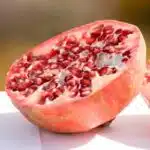Growing pomegranate trees is like crafting a masterpiece; it requires thoughtful care and attention to detail. With the right know-how and resources, anyone can grow these vibrant and delicious superfoods in their own garden or backyard. The sweet taste of success that comes from growing a hearty pomegranate tree makes all the hard work worthwhile.
Whether you have limited outdoor space, or an expansive garden, there are some key tips to bear in mind when it comes to cultivating these robust plants. From selecting the right variety of pomegranate tree for your climate, to properly caring for your sapling during its first year of growth, this article will provide you with all the information needed to ensure that your harvest is plentiful and healthy.
Finally, we will discuss how best to maintain your pomegranate tree so that it continues producing quality fruit season after season. So if you’re looking for an exciting gardening challenge that can benefit both you and your community, then growing pomegranates may just be the perfect project for you!
Choose The Right Variety Of Pomegranate Tree
When it comes to growing pomegranate trees, it’s important to first select the right variety. Think of it as if you are building a house – the foundation must be strong for the structure to remain standing. This analogy can be applied to selecting the right variety of pomegranate tree; no matter how carefully you tend to it, an unsuitable variety will not produce desired results.
Take for example, “Rio Red,” a hardy variety that is easy for beginners and has been known to produce excellent yields. With its deep pinkish-red skin and juicy fruit, this type of tree is ideal for those looking for a stunningly beautiful addition to their garden or yard. Additionally, Rio Red is drought-tolerant and can handle temperatures down to 15 degrees Fahrenheit (-9 Celsius).
On the other hand, varieties like “Sweet Scarlet” require more care and attention due to their sensitivity towards cold temperatures and high humidity levels. Despite this increased need for attention, Sweet Scarlet offers larger fruit with sweeter flavor than Rio Red – making them a desirable choice for those willing to put in extra effort.
Selecting the right variety of pomegranate tree is key in ensuring success when growing these fruits. Once you’ve chosen your preferred type, it’s time to pick out a suitable location for planting!
Select The Right Location For Planting
Choosing the right location for planting a pomegranate tree is just as important as selecting the proper variety. Much like picking out a home for a loved one, you need to take into account the needs of your tree in order to ensure it will thrive and bear fruit for years to come. To make sure your tree has a chance to grow its best, here are a few key points to consider:
First, pick an area that provides plenty of sunlight. Pomegranate trees love the heat and require at least 8 hours of direct sunlight each day. If possible, shield your tree from winter winds and provide some form of protection from heavy rains or snowfall.
Second, consider soil type. The best soil type for pomegranates is light and well-draining with a pH between 5.5 and 7.0; test your soil’s pH level before planting if possible. If you find that your soil is too acidic or alkaline, amend it with organic matter such as compost prior to planting your tree.
Third, think about water availability and drainage in the area you plan to plant your tree in; pomegranates prefer moist but not soggy soils so be sure there’s good drainage around the roots of the tree so they don’t become waterlogged. Mulching around the base of the tree can help retain moisture while also controlling weeds and preventing erosion in rainy weather conditions.
Finally, plan ahead when it comes to spacing considerations; pomegranate trees can reach heights up to 15-20 feet so make sure there will be enough room for them to spread their branches without any obstruction from other plants or structures in order to get maximum amount of sun exposure throughout their lifetime.
By taking these factors into account before planting, you’ll be giving your pomegranate tree an ideal setting where it can reach its full potential! Now all that’s left is preparing the soil for planting – let’s dive into what must be done next!
Prepare The Soil For Planting
The third step for growing pomegranate trees is to prepare the soil for planting. To ensure success, it’s important to consider the type of soil that best suits pomegranates. It should be well-draining and rich in organic matter. Consider adding compost or aged manure to boost fertility and improve drainage. Additionally, mix in a slow-release fertilizer with a balanced nitrogen-phosphorus ratio.
Once you’ve prepared the soil, you’re ready to move on to the next stage: planting your pomegranate tree. Before doing so, take time to determine how deep and wide to dig the hole. The size of the hole should roughly match that of the root ball or container it came in. Planting too deeply can lead to unhealthy roots, while leaving too much exposed can cause water runoff and erosion.
With these tips in mind, you’re well on your way to enjoying an abundant harvest of juicy pomegranates! All that’s left is to plant your pomegranate tree and get it off to a healthy start in its new home.
Plant The Pomegranate Tree
When it comes to planting your pomegranate tree, there are a few things you need to keep in mind. First and foremost, make sure the location you choose is well drained and sunny. Pomegranate trees require at least six hours of direct sunlight each day for optimal growth. You also want to make sure that the soil is fertile and well aerated, as this will help ensure your tree grows healthy and strong.
Once you’ve chosen your location and prepped the soil, it’s time to plant your pomegranate tree! Start by digging a hole that is twice as wide as the root ball of the tree. Place the tree in the hole so that it is at the same depth as it was previously growing. Backfill with soil and use your hands or feet to press down around the base of the tree to ensure good contact with the soil. Finally, give your new pomegranate tree a thorough watering.
Now that you have planted your pomegranate tree, it’s important to understand its watering requirements for optimal health and longevity. With careful attention given to both planting and watering needs, you can look forward to an abundance of delicious fruits from your own backyard!
Watering Requirements For Pomegranate Trees
Watering your pomegranate tree is like giving it a hug – it’s essential for its health and growth. Without the right amount of water, these trees won’t bear fruit or thrive. Let’s take a look at what you need to know about watering requirements for pomegranate trees.
When it comes to how much water your pomegranate tree needs, the answer isn’t clear-cut. It depends on a variety of factors such as the tree’s age, soil type, and environment. Generally speaking, young trees need more frequent watering than mature trees – both should be watered deeply whenever their topsoil becomes dry. To determine if your tree needs to be watered, simply stick your finger into the soil up to 2” deep and feel for moisture – if it’s dry, then water your tree slowly and thoroughly until it runs out from the bottom of the pot or container.
Be careful not to over-water your pomegranate tree as this can lead to root rot or other problems. Avoid wetting the leaves of your tree and try not to let them sit in stagnant water for too long. If you’re unsure about how often you should be watering your pomegranate tree, consult an experienced gardener or local nursery for advice specific to your area and climate conditions.
With proper care and attention, you can ensure that your pomegranate tree stays healthy enough to produce juicy fruit year after year. Now that we’ve discussed watering requirements let’s move on to fertilizing these vibrant trees…
Fertilizing Pomegranate Trees
Fertilizing pomegranate trees is like adding the final touches to a painting; it’s the special ingredient that can bring out their full potential. Here are a few key points to remember when fertilizing pomegranate trees:
• Use a fertilizer specifically designed for fruit-bearing trees. • Apply the fertilizer twice a year in early spring and mid-summer. • Follow product instructions carefully for application rates.
When applying fertilizer, it’s important to remember that too much of it can actually be detrimental to your tree’s growth. Overfertilizing will encourage overly lush foliage and reduce the number of flowers and fruit produced by your tree. It’s best to err on the side of caution and stick with the recommended amounts listed on your fertilizer package. Additionally, you should always water your tree after applying any type of fertilizer so that it can absorb all its nutrients properly.
Finally, you won’t need to worry about pruning your pomegranate tree until it has established itself in its new home, usually after two or three years. Pruning will help keep your tree healthy and productive over time, allowing more air circulation and light penetration into its center branches which helps with overall flowering and fruiting production.
Pruning A Pomegranate Tree
Pruning a pomegranate tree is an important part of the tree’s health and should be done regularly. It encourages new growth and helps to shape the structure of the tree. If you’re looking to get the most out of your pomegranate tree, then pruning is essential.
When pruning your pomegranate tree, always make sure to use sharp tools. This will help prevent any damage that can occur from dull blades or instruments that don’t fit correctly. Also, it’s important to make sure you remove any dead or damaged branches before doing any major pruning. This will help to keep the overall health of your tree in check and reduce chances of disease.
After removing the dead wood, it’s time for shaping the pomegranate tree. Start by thinning out any overcrowded branches and removing any weak stems that won’t contribute much to future growth. Then focus on providing support for branches with multiple fruits by using stakes or wires if needed. Doing this will ensure that all parts of the plant get enough sunlight and air circulation for healthy growth.
By following these steps, you can easily create a balanced structure for your pomegranate tree that will provide optimal conditions for fruit production in the long run. Now that we’ve covered how to prune a pomegranate tree, let’s look at ways to control pests and diseases on them as well.
Controlling Pests And Diseases On Pomegranate Trees
Controlling pests and diseases on pomegranate trees can be a challenge, so it’s important to be proactive. But, don’t worry – with the right preparation and knowledge, you can keep your pomegranate trees healthy and thriving. To start off, let’s take a look at some of the common pests and diseases that can affect the growth of pomegranate trees.
One of the most common pests for pomegranate trees is aphids. They feed on sap from leaves and stems, damaging foliage and stunting growth. To prevent infestations, inspect your tree regularly for signs of pests. If you notice any signs of damage or infestation, you should use insecticides or organic methods such as neem oil to help control them.
In addition to insects, fungal diseases like powdery mildew can also affect your pomegranate trees. This fungus usually appears as white spots on leaves and stems. To prevent this disease in the first place, ensure that your tree has adequate air circulation between its branches – pruning away any overgrown limbs may help here. If the disease does occur however, fungicides are usually effective at removing it from your tree.
By taking preventative measures and knowing how to deal with any pest or disease problems quickly, you’ll be able to keep your pomegranate tree healthy and productive throughout the year. With these tips in mind, let’s move onto harvesting pomegranate fruit – something that all gardeners look forward to!
Harvesting Pomegranate Fruit
Harvests typically take place in the fall season when pomegranates become ripe, and can be a rewarding experience. To ensure that you get the best fruit possible, here are some tips on harvesting pomegranates. First, it’s best to wait until the fruit has turned mostly red before harvesting. If picking off the tree is difficult, you can cut the stem close to the fruit with pruning shears or scissors. You’ll want to handle your pomegranates carefully, as they’re fragile fruits that bruise easily.
When it comes time to pick them off of your tree, try to find a container that will fit comfortably in both hands so you don’t drop any of your newly-harvested bounty. Be sure to inspect each one for signs of disease or damage before putting them into the container. Additionally, if you’re picking from multiple trees, make sure not to mix fruits from different trees together – this will help prevent cross-contamination of any diseases or pests.
Once all your fruits have been gathered up, it’s time to move on to storing them properly for future use! With proper storage techniques, you can extend their shelf life and enjoy your delicious pomegranates for months after harvest season has passed.
Storing Fresh Pomegranates
Gathering the sweet, juicy fruits of a pomegranate tree is only half the battle; one must also know how to store them correctly, or risk losing out on their goodness. Like a butterfly emerging from its cocoon, proper storage techniques can help these fruits live up to their fullest potential.
Preserving fresh pomegranates requires a little bit of effort and finesse. To start, it’s important to note that the fruit should be stored in a cool, dry place away from direct sunlight – think of it like treasuring an unexpected gem! It’s also best to keep them loosely wrapped in plastic or paper bags and away from other fruits or vegetables that may easily bruise them. Furthermore, any pomegranate with visible damage should be discarded immediately; they are highly perishable and will soon go bad if not eaten right away.
It’s also possible to freeze fresh pomegranates for up to four months when properly sealed in an airtight container or baggie. When ready to eat, simply thaw them overnight in the refrigerator before cutting them open and enjoying their sweet rewards!
With these simple steps in mind, you’ll be well on your way towards propagating your own perfect pomegranate tree.
Propagating Pomegranate Trees
Propagating pomegranate trees is like having a baby: it takes a lot of care to raise them. Just like with babies, you will need patience and dedication when propagating your pomegranate trees. A great way to start is by taking cuttings from existing trees or purchasing pre-started plants. You can even purchase seeds if you want to get creative!
Once your new pomegranate tree starts growing, you’ll need to make sure it gets the proper amount of sunlight and water. It’s also important that you prune away any dead branches or shoots in order to ensure the tree grows strong and healthy. Additionally, you should use an appropriate fertilizer for your plant. This will provide the necessary nutrients for optimal growth.
By following these steps, you’ll be well on your way to having a thriving pomegranate tree that produces delicious fruits for years to come. And with the proper training and trellising techniques, you can grow an impressive looking tree that will be the envy of all your neighbors!
Training And Trellising Pomegranate Trees
Training and trellising pomegranate trees is absolutely essential to ensure the best possible yield. It’s like a hidden art form that, if applied correctly, can open up a world of amazing fruit!
When it comes to training and trellising, the most important thing you need to do is make sure your tree is planted in well-draining soil with plenty of space around it. This will give you more room to prune and train the tree as it grows. You should also consider planting two or more trees together so that they can naturally support each other as they grow.
Once the trees are in place, there are several techniques you can use for training and trellising. One popular technique is tying the branches down on either side of a stake or trellis to create an arch shape. This helps keep the fruits off the ground and makes them easier to harvest. Additionally, pruning can help encourage new growth as well as promote better air circulation around your plants.
By investing a bit of time into learning these techniques now, you’ll be able to reap the rewards of perfectly trained pomegranate trees later on – where winter care will help ensure they stay healthy all year round!
Winter Care For Pomegranate Trees
Providing the right care is essential for successful pomegranate tree growth. Wintertime can be a challenging period, however, with some thoughtful preparation and dedication you’ll have your tree flourishing in no time. Here are a few tips to help ensure your pomegranate tree thrives during the cold season:
Monitor temperature: Be sure to keep an eye on temperature fluctuations in your area. Pomegranate trees are more vulnerable to frost when temperatures drop below freezing.
Mulch: Provide ample mulch around the base of your tree to help insulate it from the cold and provide protection from extreme temperatures or winds.
Watering: Don’t forget about watering! Though it may seem counterintuitive, you’ll want to make sure your pomegranate tree is getting enough moisture throughout winter months. This can help protect against winter damage caused by cold and windy conditions.
With these key steps in mind, you’ll be well on your way towards providing a safe and healthy environment for your pomegranate tree this winter season. Now let’s look into how having your pomegranate trees in containers can make growing them even easier.
Container Growing Pomegranate Trees
Container growing pomegranate trees is an excellent way to get started with a home orchard. It’s a great option if you don’t have much space, or want to move the tree around during different seasons. When selecting a container for your tree, make sure it’s wide and deep enough to accommodate a full-sized root ball and has drainage holes in the bottom. If you live in an area where temperatures dip below freezing, choose a pot that can easily be carried indoors during winter months.
When planting, use soil specifically designed for containers or make your own blend of equal parts peat moss, perlite, and loam soil. Plant your tree at the same level it was planted in its original pot and water thoroughly until you see water draining from the bottom of the container.
To ensure healthy growth for your pomegranate tree, give it plenty of light and water throughout the growing season. To keep moisture levels up, spread organic mulch around the base of your pomegranate tree and consider using a slow-release fertilizer as well as regular applications of liquid fertilizer every two weeks during peak growing periods. With proper care and attention, you’ll soon be reaping the rewards of homegrown pomegranates!
Common Problems With Pomegranate Trees
Growing pomegranate trees is a rewarding experience, but it can also come with its own set of problems. Common issues include pests like mites and thrips, as well as fungal diseases like root rot or powdery mildew. It’s important to understand how to identify and address these issues in order to ensure your pomegranate tree grows healthy and strong.
The first step in minimizing any common problems with your pomegranate tree is selecting the right location for planting. Choose an area that has good air circulation and plenty of sunlight, and make sure the soil is deep enough for proper root growth. Also be sure to water regularly, as this will help prevent fungal diseases from taking hold.
Finally, keep an eye out for signs of pests like mites or thrips. If you spot any, treat them quickly with approved insecticides or other methods before they spread to other plants in your garden. Taking these steps can help you minimize common problems with your pomegranate tree and ensure it has the best chance of growing lush and vibrant!
Frequently Asked Questions
How Far Apart Should Pomegranate Trees Be Planted?
When it comes to pomegranate trees, planting space is key. Knowing how far apart to plant your trees will help them grow healthy and strong. Here are some tips for spacing your pomegranate trees:
First, when planting two or more trees in a row, make sure the trees are spaced at least 12 feet apart. If you’re planting multiple rows of trees, leave 15 feet between rows. Additionally, the wider the spacing between each tree in a row or between rows, the better chance of good air circulation and sun exposure for your pomegranate tree.
Here are a few other things to consider when planting and spacing your pomegranate trees: • Ensure that each tree has access to plenty of sunlight throughout the day • Prune regularly as needed to maintain proper airflow • Water each tree evenly during dry weather periods
These tips will help ensure that your pomegranate trees have all the necessary conditions they need to flourish and bear fruit. As long as you’re mindful of your planting space and take good care of your trees with regular watering and pruning, you’ll be able to enjoy sweet and juicy pomegranates from your own backyard!
How Often Should The Pomegranate Tree Be Fertilized?
Fertilizing pomegranate trees is an essential part of their health and growth. Without adequate nutrition, they won’t be able to reach their full potential. But how often should you be fertilizing your pomegranate tree? Let’s look at the answer.
First, it’s important to understand the types of nutrients that a pomegranate tree needs for proper growth. This includes nitrogen, phosphorus, potassium, and micronutrients like calcium and magnesium. You’ll want to select a fertilizer that provides these necessary nutrients in the right ratios for your specific tree type.
Once you’ve chosen the appropriate fertilizer, it’s time to decide how often you should apply it. Generally speaking, an established pomegranate tree should be fertilized two or three times each year—once in early spring before new growth appears, then again in late spring or early summer when the fruit begins to set, and finally in mid-summer when the fruits are ripening.
To ensure your pomegranate tree is getting all the nutrition it needs: • Create a fertilizing schedule specific for your climate and soil type: ◦ Consider adding organic matter like compost into your soil on an annual basis ◦ Schedule regular soil tests to check nutrient levels • Follow label instructions carefully when applying fertilizer: ◦ Measure accurately so that you’re not over-fertilizing your trees ◦ Allow rainfall or irrigation between applications to help distribute nutrients evenly throughout the root zone
By following these steps and understanding how often to fertilize your pomegranate tree, you can give it the best chance of growing strong and healthy throughout its lifetime!
Can I Grow A Pomegranate Tree In A Pot Or Container?
Growing pomegranate trees in pots or containers is a great way to enjoy the beauty and bounty of these wonderful plants. But, is it possible? Fortunately, yes! While it may take more effort than growing them in the ground, with care and attention you can successfully cultivate a pomegranate tree in a pot or container.
To get started, pick an appropriate container for your tree. A large pot or container will be necessary for a mature tree, as they need plenty of room to grow their roots. Be sure to use good quality soil and make sure it is well-draining. You’ll also want to keep an eye on water levels; too much water can lead to root rot, while not enough will result in stunted growth. Additionally, the pomegranate tree needs lots of sun exposure so make sure the pot or container is placed in an area that gets full sun for most of the day.
Finally, fertilizing your pomegranate tree regularly will help provide essential nutrients that promote healthy growth and fruiting. An organic fertilizer with balanced nitrogen, phosphorus, and potassium is ideal for promoting strong root systems and lush foliage. For best results, fertilize every two weeks during the growing season and less often during winter months when the plant goes dormant. With proper care and maintenance you can enjoy homegrown pomegranates right from your own backyard!
What Is The Best Time Of Year To Prune Pomegranate Trees?
Pruning pomegranate trees can be a daunting task for many gardeners. It’s important to know when the best time of year is to prune your tree, as this could make all the difference in your success. Taking the time to understand when and how to prune pomegranate trees will help ensure that they remain healthy and vibrant.
The best time of year to prune your pomegranate tree is in the late winter or early spring of each year, before new growth begins. Pruning during this period gives you the opportunity to assess any damage from winter storms, remove dead branches, and shape the tree for future growth. You should also look out for any signs of disease or pest infestations that may require additional attention.
Before you begin pruning, it’s important to properly equip yourself with a pair of clean, sharp pruning shears and gloves so that you can safely trim away any dead or overgrown branches. With careful attention to detail and patience, you can keep your pomegranate tree looking its best throughout the season!
How Long Does It Take For Pomegranate Trees To Produce Fruit?
Pomegranate trees are known for their gorgeous and delicious fruit. But many people wonder how long it will take them to enjoy the fruits of their labor. The answer depends on a variety of factors, including the tree’s age, climate, soil type, and pruning regimen.
Take Roberta’s experience as an example. She planted her pomegranate tree in her backyard when it was only three feet tall. She made sure to water and fertilize it regularly according to her local gardening professional’s advice. After two years of patient care, she finally began to see small green fruits dotting the branches. With continued care and attention, the tree produced its first full harvest of pomegranates two years later.
So how long does it take for a pomegranate tree to produce fruit? Generally, with proper care and attention, a pomegranate tree can start producing fruit in around two years after planting and reach its full potential in four or five years. Pruning is also important as it helps stimulate new growth which can increase fruiting potential earlier on in the tree’s lifespan.
No matter what kind of climate you live in or what type of soil your pomegranate tree is planted in, patience will be your best ally when growing this delightful fruit-bearing tree! With regular upkeep and pruning, you can look forward to harvesting your own sweet and juicy pomegranates within a few short years!
Conclusion
The pomegranate tree is an interesting and complex fruit tree with many different aspects to consider when growing. From planting, fertilizing, pruning, and harvesting, there is a lot of work involved in growing pomegranate trees. But the rewards are also great! The fruits are delicious and can be used in many dishes or enjoyed fresh.
So if you want to try your hand at growing pomegranates, make sure you give them the care they need to thrive. Take the time to research the best spacing for planting, how often to fertilize them, what type of container is best for growing them in, and when it’s best to prune them. And don’t forget that patience is key – it might take a few years before you get your first harvest!
In conclusion, with a little bit of knowledge and effort, anyone can have success growing pomegranate trees. From novice gardeners to expert growers alike – we all have something to learn about cultivating these beautiful plants. So why not give it a try? You just might end up with a bountiful harvest of tasty fruits!





























